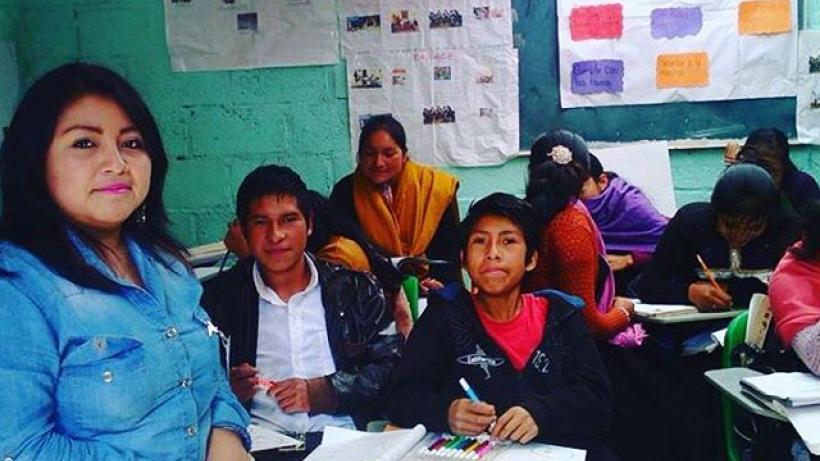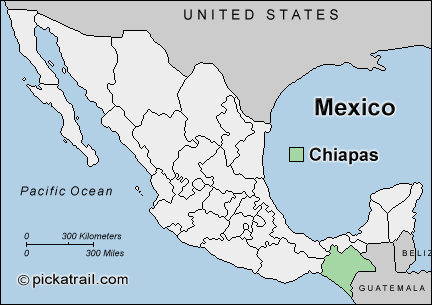
Escalera: Stairway to better education, evidence from rural Mexico
As a basic input to human capital development, access to quality education remains a significant barrier to growth in most developing countries. Today’s blog looks at evidence of an innovative NGO approach that has been tested in Chiapas, Mexico’s poorest state.
However you look at it, Chiapas is the poorest state in Mexico. Its per capita income (34,751 pesos, or just over $2,000USD) is the lowest of the 32 states[1], only 40% of the national average, and its growth rate lags behind the rest of Mexico (only 0.2% between 2003 and 2013). The reasons for the state’s underdevelopment have long been of interest to academics, including Harvard’s Center for International Development which recently released the findings of their year-long research initiative. They note that the main reason for the state’s slow development is its limited productivity capacity – Chiapas is one of the lowest per-capita exporting states in Mexico with a heavy concentration on agricultural commodities. The study finds that while major constraints to productivity and trade come from Chiapas’ topography and climate, its low levels of educational achievement may also explain the gap.

With an illiteracy rate of 18% (compared to the national average of 7%). Chiapas ranks last out of all the states in Mexico in average years of schooling (see Figure 1) – 16.5% of people 15 years or older receive no schooling at all.

Which approaches could help Chiapas unlock its human capital potential?
Working to identify and fight these barriers, Fundación Escalera created the REACH programme. Escalera means stair in Spanish, capturing the mission of the organisation –helping poor students in rural Mexico climb out of poverty through high school education. They first funded high school scholarships for children in rural villages around Mexico City, but soon turned their attention to Chiapas, in an effort to target resources to areas most in need. The problem appears to be a supply and a demand issue, depending on the context. Some areas are constrained an insufficient number of schools for the number of school-aged children present, while in areas where schools are available, attendance rates still remain low.
To remedy the supply problem, in 2008 Escalera developed a prefabricated school building. They went on to build 173 classrooms throughout Chiapas over the next seven years. In 2009, the Chiapas State Government adopted the innovation, and built thousands of new classrooms, at a rate faster than any other Mexican state. Addressing the demand issue, Escalera’s launched a Star Scholarship programme, awarding funds to students continuing on to high school. From 2011 – 2013 it reached over 24,000 students.
Through this long engagement, Escalera began collecting information on risk factors that prevented students from continuing on to high school. Students in rural Chiapas typically have limited or no access to internet and print media, and often face both geographic and language barriers. An estimated 14% don’t speak Spanish.
Surprisingly, Escalera found that even after easing barriers to access, attendance remained low. High schools and trade schools were under-enrolled and scholarship funds went unused. The reason, they hypothesised, was a lack of available information.
REACH: An innovative information campaign
So how can an organisation bridge this information gap? In 2013, Escalera pioneered the REACH programme, using positive role models to motivate middle-schoolers and encourage further schooling.
Escalera found that even after easing barriers to access, attendance remained low. High schools and trade schools were under-enrolled and scholarship funds went unused. The reason, they hypothesised, was a lack of available information.
With the support of the Ministry of Education in Chiapas, they delivered a High School Prep Kit to ninth grade teachers at the start of the school year. The kit contained the following:
- 18 video interviews with local high school graduates;
- 28 motivational and informational activities in a student workbook;
- Information on scholarships available for local high schools; and
- Information on student housing and transport.
Escalera also trains teachers to implement their new curriculum – to date, over 500 teachers and educational advisors have received training. The programme aims to stimulate children to think about identity, self-esteem, life goals, and how they can give back to the community. By working with local role models and raising awareness of funding, Escalera plans to target over one million Mexican students and raise high school attendance.
Escalera utilises a range of methods to quantify REACH’s impact. Additional assessment and feedback is collected through teacher focus groups and student surveys. Nearly 3,000 students were surveyed last year at the beginning and end of the school year to assess changes in beliefs, plans, self-esteem and attitudes towards schooling. Progress has been impressive. During 2014 – 2015, REACH served 5,400 students in 156 middle schools. An additional 1,540 students were offered scholarships to attend high school (over a 1000 students, so far, have received scholarships).
Evaluating the impact of REACH
To measure REACH’s impact in its first year, middle schools were randomly assigned to one of four groups: a group receiving only the REACH curriculum, a group solely receiving a subsidy paying for students’ high school tuition fees, a group receiving both, and a control group for comparison. Schools were randomised based on size and distance to San Cristobal de las Casas, the major urban area of the Los Altos Region.
Of the 117 telesecundarias (lower secondary schools) in Los Altos, 28 schools were randomly assigned to receive REACH materials, 29 were offered school fee subsidies, 32 schools received both, and 28 schools were kept as for control. Data was collected by enumerators in February 2014. Over 2,600 students were surveyed from 114 telesecundarias.
High school enrolment data was collected from all high schools in Los Altos. The data was verified and matched using students’ CURP, the Mexican national identification number. Results were analysed using a probit model. Students who received REACH were 3.4% more likely than the control group to enrol in high school, students receiving the subsidy were 7.4% more likely to enrol, and students receiving both were 8.4% more likely to enrol. Once standard errors are clustered at the school level, none of these coefficients are statistically significant. However, when the distance from a student’s home to the nearest high school is controlled for, the subsidy treatment and the combined REACH and subsidy treatments rise to 13% and 12%, respectively (at 95% and 90% confidence intervals).
The evaluation found that the most important factor that seemed to affect programme impact was teacher quality. Students whose teachers implemented the entire REACH curriculum were 10% more likely to continue and enrol in high school. However, Escalera acknowledges that this is likely to be an endogenous variable, making it hard to precisely measure the effect of the programme. Or more simply, if better teachers are more likely to implement the entire programme, increased enrolment from their students could be the result of teaching quality and not necessarily exposure to the REACH programme.
Thus Escalera also estimated the intent to treat (ITT) effect, using the random treatment assignment as an instrument for probability of implementing the programme. They cannot yet causally attribute educational gains to the REACH programme. The key flaw in this impact evaluation is the fact that it is under-powered. Escalera has limited baseline data on the percentage of students that continue on to high school after middle school. The rate of enrolling in high school among the control group in this evaluation is about 43%. Materials distributed by REACH were doubled in the second round (2014-2015), with an emphasis on increased communication with teachers to encourage them to implement the entire curriculum.
Future plans for expansion and scale-up
So what lies ahead for Escalera’s programmes? 2015 was their biggest year yet. By 2017, Escalera plans to expand REACH to all middle schools in Chiapas in an effort to raise high school enrolment by over 11,00 students. Escalera’s long term ambitions centre on scaling REACH up as a state-wide policy initiative in Chiapas.
Image Credit: Escalera Fund
To read more about REACH, please visit the project’s blog.

